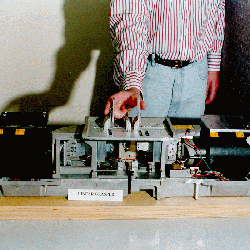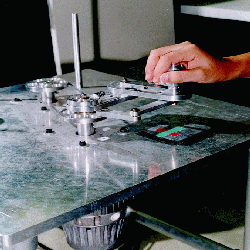 
Over the past few years, we have developed device hardware, interaction
software and psychophysical experiments pertaining to haptic interactions
with virtual environments (general reviews on haptic interfaces can be
found in Srinivasan, 1994;1995a,b). Two major devices for performing psychophysical
experiments, the Linear and Planar Graspers, have been fitted with additional
sensors for improved performance. The Linear Grasper is now capable of
simulating fundamental mechanical properties of objects such as compliance,
viscosity and mass during haptic interactions. Virtual wall and corner
software algorithms were developed for the Planar Grasper, in addition
to the simulation of two springs within its workspace.
|
|
  Another
haptic display device developed previously, the PHANToM, has been used
to prototype a wide range of force-based haptic display primitives. A
variety of haptic rendering algorithms for displaying the shape and texture
of solid surfaces have been implemented on the PHANToM. All the three
devices have been used to perform psychophysical experiments aimed at
characterizing the sensorimotor abilities of the human user and the effectiveness
of computationally efficient rendering algorithms in conveying the desired
object properties to the human user. Another
haptic display device developed previously, the PHANToM, has been used
to prototype a wide range of force-based haptic display primitives. A
variety of haptic rendering algorithms for displaying the shape and texture
of solid surfaces have been implemented on the PHANToM. All the three
devices have been used to perform psychophysical experiments aimed at
characterizing the sensorimotor abilities of the human user and the effectiveness
of computationally efficient rendering algorithms in conveying the desired
object properties to the human user.
|


